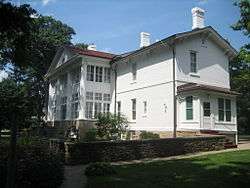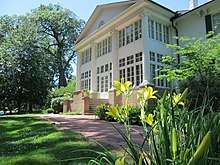Paul W. Dillon Home
The Paul W. Dillon Home, also known as the Colonel Edward N. Kirk House, is located in Sterling, Illinois. It was home to businessman P.W. Dillon, who was the president of Northwestern Steel & Wire Company for many of its most successful years. The home was added to the National Register of Historic Places in 1980.
Col. Edward N. Kirk House | |
 The rear elevation of the Kirk House. | |
| Location | Sterling, Illinois |
|---|---|
| Built | 1857 |
| Architectural style | Italianate |
| NRHP reference No. | 80001417 |
| Added to NRHP | October 9, 1980 |
History
Dating back to Nelson Mason in 1841 the property has 33 owners. The home on today's property was constructed in 1857 by Colonel Edward N. Kirk and is cast in the Italianate style. After Kirk built the home in 1857 the property was owned by eleven different people until Washington M. Dillon purchased it from Joseph Patterson in 1882.
Dillon's son, Paul W. Dillon, was born in the house on June 3, 1883 and resided there until his death in February 1980. It was the consensus of the Dillon family heirs, after Paul W. died, that the home, its furnishings and all of its artifacts be turned over to the Sterling Park District for future generations to enjoy. The home was transferred to the park district on May 1, 1980. The Paul W. Dillon Home-Museum opened to the general public on 18 November 1980. Between November 1980 - May 1981 over 5,000 people visited the house. The museum is open for regular tour times and also available for private group tours. A new display showcases the original owners, Edward and Eliza Kirk, and the builder of the home, Edwin Allen. Kirk actually rose to the rank of Brigadier General shortly before his death as result of being shot at the Battle of Stone's River in Murfreesboro, TN. Four Brigadier Generals lost their lives as a result of that battle.
The Dillon legacy began generations ago when P.W.'s great-great-great grandfather, Moses, started the first iron forge near Zanesville, Ohio around 1808. From there, the Dillon men worked in and pioneered new technologies in the industrial metal manufacturing business. P.W. went on to built the largest electric arch furnace in the world with the help of his chief engineer, Charlie Bosco. P.W. was a hold-out for steam power, refusing to move over to diesel engines, despite them taking over as switch engines as early as the 1950s. In fact, the 1929 Baldwin engine that sits on the grounds was one of the last daily-fired working steam engine in the entire United States. People used to come from all over the world to watch the switch steam engines at Northwestern.

External links
| Wikimedia Commons has media related to Paul W. Dillon Home. |
- Sterling Park District: Dillon Home Museum
- Sterling-Rock Falls Historical Society
- Potpourri: Illinois Parks and Recreation 12 May/June 1981
- National Register of Historic Places: Whiteside County, Illinois